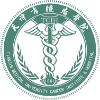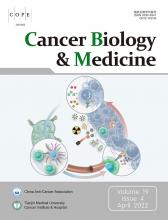Research ArticleOriginal Article
Comparative profiling of immune genes improves the prognoses of lower grade gliomas
Zhiliang Wang, Wen Cheng, Zheng Zhao, Zheng Wang, Chuanbao Zhang, Guanzhang Li, Anhua Wu and Tao Jiang
Cancer Biology & Medicine April 2022, 19 (4) 533-550; DOI: https://doi.org/10.20892/j.issn.2095-3941.2021.0173
Zhiliang Wang
1Department of Neurosurgery, Beijing Neurosurgical Institute, Capital Medical University, Beijing 100050, China
Wen Cheng
2Department of Neurosurgery, The First Hospital of China Medical University, Shenyang 110001, China
Zheng Zhao
1Department of Neurosurgery, Beijing Neurosurgical Institute, Capital Medical University, Beijing 100050, China
Zheng Wang
3Department of Neurosurgery, Beijing Tiantan Hospital, Capital Medical University, Beijing 100050, China
Chuanbao Zhang
3Department of Neurosurgery, Beijing Tiantan Hospital, Capital Medical University, Beijing 100050, China
Guanzhang Li
1Department of Neurosurgery, Beijing Neurosurgical Institute, Capital Medical University, Beijing 100050, China
Anhua Wu
2Department of Neurosurgery, The First Hospital of China Medical University, Shenyang 110001, China
Tao Jiang
1Department of Neurosurgery, Beijing Neurosurgical Institute, Capital Medical University, Beijing 100050, China
3Department of Neurosurgery, Beijing Tiantan Hospital, Capital Medical University, Beijing 100050, China

References
- 1.↵
- 2.↵
- Louis DN,
- Ohgaki H,
- Wiestler OD,
- Cavenee WK,
- Burger PC,
- Jouvet A, et al.
- 3.↵
- 4.
- 5.↵
- 6.↵
- Zhang C,
- Cheng W,
- Ren X,
- Wang Z,
- Liu X,
- Li G, et al.
- 7.
- Chen Q,
- Han B,
- Meng X,
- Duan C,
- Yang C,
- Wu Z, et al.
- 8.
- Cai J,
- Chen Q,
- Cui Y,
- Dong J,
- Chen M,
- Wu P, et al.
- 9.↵
- Wu P,
- Geng B,
- Chen Q,
- Zhao E,
- Liu J,
- Sun C, et al.
- 10.↵
- Zha C,
- Meng X,
- Li L,
- Mi S,
- Qian D,
- Li Z, et al.
- 11.↵
- Qiu H,
- Li Y,
- Cheng S,
- Li J,
- He C,
- Li J.
- 12.↵
- 13.↵
- Wang ZL,
- Zhao Z,
- Wang Z,
- Zhang CB,
- Jiang T.
- 14.↵
- 15.↵
- Garcia D,
- MacDonald S,
- Archer T.
- 16.↵
- DeCoster J,
- Gallucci M,
- Iselin AMR.
- 17.↵
- Zeng D,
- Li M,
- Zhou R,
- Zhang J,
- Sun H,
- Shi M, et al.
- 18.↵
- 19.↵
- Wang Z,
- Hao Y,
- Zhang C,
- Wang Z,
- Liu X,
- Li G, et al.
- 20.↵
- 21.
- 22.↵
- 23.↵
- 24.
- He Y,
- Rivard CJ,
- Rozeboom L,
- Yu H,
- Ellison K,
- Kowalewski A, et al.
- 25.↵
- Parry RV,
- Chemnitz JM,
- Frauwirth KA,
- Lanfranco AR,
- Braunstein I,
- Kobayashi SV, et al.
- 26.↵
- Han S,
- Zhang C,
- Li Q,
- Dong J,
- Liu Y,
- Huang Y, et al.
- 27.↵
- 28.↵
- 29.↵
- 30.↵
- Gilbert PM,
- Mouw JK,
- Unger MA,
- Lakins JN,
- Gbegnon MK,
- Clemmer VB, et al.
- 31.↵
- Quintanar JL,
- Guzman-Soto I.
- 32.↵
- Bethin KE,
- Vogt SK,
- Muglia LJ.
- 33.↵
- Batchu RB,
- Gruzdyn OV,
- Kolli BK,
- Dachepalli R,
- Umar PS,
- Rai SK, et al.
- 34.↵
- Said EA,
- Dupuy FP,
- Trautmann L,
- Zhang Y,
- Shi Y,
- El-Far M, et al.
- 35.↵
- Cai J,
- Zhang W,
- Yang P,
- Wang Y,
- Li M,
- Zhang C, et al.
- 36.
- 37.↵
- Meng X,
- Duan C,
- Pang H,
- Chen Q,
- Han B,
- Zha C, et al.
- 38.↵
- Lopes RL,
- Borges TJ,
- Zanin RF,
- Bonorino C.
- 39.↵
- Laffer B,
- Bauer D,
- Wasmuth S,
- Busch M,
- Jalilvand TV,
- Thanos S, et al.
- 40.↵
- 41.
- Liu CY,
- Xu JY,
- Shi XY,
- Huang W,
- Ruan TY,
- Xie P, et al.
- 42.↵
- Qi L,
- Yu H,
- Zhang Y,
- Zhao D,
- Lv P,
- Zhong Y, et al.
- 43.↵
- 44.↵
- Cheng W,
- Zhang C,
- Ren X,
- Wang Z,
- Liu X,
- Han S, et al.
In this issue
Comparative profiling of immune genes improves the prognoses of lower grade gliomas
Zhiliang Wang, Wen Cheng, Zheng Zhao, Zheng Wang, Chuanbao Zhang, Guanzhang Li, Anhua Wu, Tao Jiang
Cancer Biology & Medicine Apr 2022, 19 (4) 533-550; DOI: 10.20892/j.issn.2095-3941.2021.0173
Jump to section
Related Articles
- No related articles found.
Cited By...
- No citing articles found.










